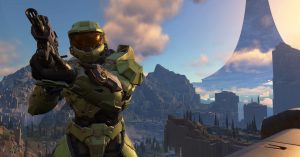The moon landscape was always the first Destiny game’s best trick. While its sequel has moved more in the direction of space opera, the original had a foot firmly planted in retro-futurist space exploration aesthetics and the broad optimism that comes with them. Things might be bad in Destiny‘s far-flung future, and evil may lurk under the moon’s surface, but space is full of possibility. It’s a joyful place to be, and walking on the crisp lunar surface, you’re meant to be reminded of humanity’s real history of space exploration and the feeling of hope that it brings. In Destiny, the moon was a place of awe.
In Destiny 2: Shadowkeep, Bungie’s first major game expansion since their break with Activision, the developer allows players to return to the moon. But Shadowkeep‘s moon isn’t a place of awe. It’s a place of trauma. In the marginalia of Destiny‘s storytelling, which is where most of its story craft up until now has resided, there’s an event called the Great Disaster which looms large over the moon’s history. During the event, thousands of Guardians—the same super-powered beings as the player character—died during a failed invasion of the moon’s enemy territory. In Shadowkeep, the Great Disaster has returned, as a host of ghosts from the tragedy dot the lunar landscape. The spectres of these dead Guardians will ask for vengeance, cry out for salvation, or else just watch; shadows of your own character hanging dead in the sky, eyes down.
The past returns in Shadowkeep in more familiar ways, too. Old bosses from the first game’s moon location and the raid set there, Crota’s End, return. Much of Shadowkeep‘s storyline is a retread of familiar locales and foes. Instead of a nostalgic vacation to days of gaming past, Shadowkeep explicitly renders this, too, as traumatic. These are not resurrected enemies but weaponized memories, living nightmares that need to be vanquished in order for the storyline to move forward. Whereas many players remember these encounters fondly, in the game they’re only considered as sites of horror. This gesture doesn’t critique the violence of Destiny—the fact that the game relies on killing things ad infinitum—but it does consider that, in the universe of Destiny, this violence leaves marks. The constant war the players fought on this moon for years has left an impression, and now that impression is back for revenge.
The decision to make Destiny 2‘s most blatant fan service yet into its first attempt at horror is a curious one, made more interesting by the way Shadowkeep changes the way the game plays. Player power has been decreased almost across the board, with weapons generally doing less base damage and special abilities taking longer to charge up for use. Partially done for balance reasons, this is also an attempt to reset the playing field in order to introduce a more explicitly stat-based armor system, which allows players to customize their gear to more deliberately build the type of character they want to play. The amount of fine detail attached to this decision is immense, but suffice it to say that every returning player entered Shadowkeep to find themselves noticeably weaker. Matching that decision, Bungie has introduced more varied and clever difficulty to the game’s encounters. Whereas before, combat in Destiny 2 typically fell into one of two categories, easy or impossible, there’s now a legitimate sense of challenge. Campaign missions in Destiny expansions are often rushed through solo, and players doing that here will find themselves struggling against the moon’s nightmares, outmatched for maybe the first time.
Shadowkeep also ushers in a new, seasonal design philosophy for the series, one where things change in the game over time. Old activities, players are being told, will sunset when the game’s seasons change. Storylines will develop and be resolved. If you leave and come back later, you might find that the solar system looks very different than you left it. This is a sharp change from the way Destiny has typically worked, where years of expansions pile on top of each other to create a solar system of disjointed stasis, one where the entire past is always already the entire present, because to change it would be to exclude new players from old content. In the name of avoiding FOMO, Destiny‘s world has always been stuck.
This, then, is the player’s explicit task in Shadowkeep: through great difficulty, you’re struggling to kill the past to make way for a more dynamic future. One has to imagine it’s a similar task to the one Bungie themselves are undertaking, breaking from the comfortable support of one of the industry’s biggest publishers to create a game that endeavors to challenge its players and transform into something completely different in the next few years. All of that tension seems to have gone into Shadowkeep, which is a haunted expansion, one that draws considerable dynamism and tension from making nostalgia horrific. Few games would be so eager to turn their own past into an explicit vector of horror and pain like this. But Destiny 2 is a game that is desperate to break from its own past—even if it has to die to do it.
More Great WIRED Stories
- The female founders disrupting the vagina economy
- Movie talk and the rise of review culture
- Jack Conte, Patreon, and the plight of the creative class
- TikTok—yes, TikTok—is the latest window into China’s police state
- Forget Mensa! All hail the low IQ
- 👁 If computers are so smart, how come they can’t read? Plus, check out the latest news on artificial intelligence
- 💻 Upgrade your work game with our Gear team’s favorite laptops, keyboards, typing alternatives, and noise-canceling headphones



